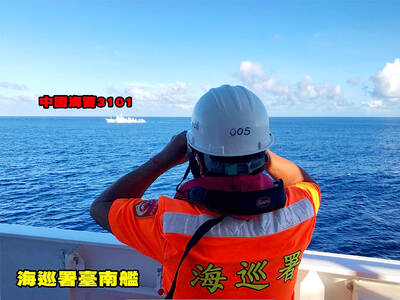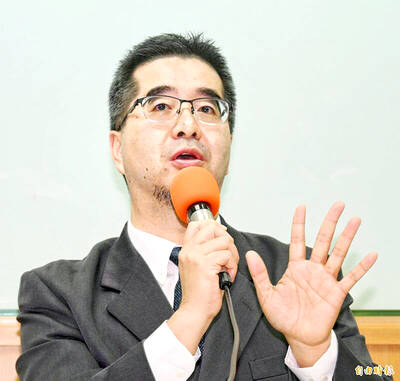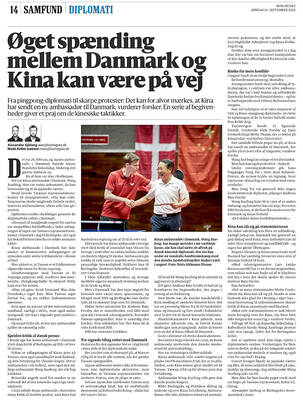The Ministry of Transportation and Communications is scheduled to propose an amendment to the Regulations on Establishing Traffic Signs and Indicating Lines (道路交通標誌標線號誌設置規則) to unify the colors of road lanes designated for different uses, which differ from region to region.
Under the proposed amendment, which has been forwarded to all local governments to solicit their opinions, the colors of pavements for lanes dedicated to bicycles, motorcycles and pedestrians must be brick-red, blue and light-green respectively.
The proposal could be promulgated in March next year at the earliest, the ministry said.
Current regulations leave the choice of pavement colors to the discretion of city and county governments, with Taipei choosing green pavements for its bike lanes, while New Taipei City (新北市) has opted for red.
However, the color green is also used to represent pedestrian lanes in Taipei, resulting in frequent confusion.
Department of Railways and Highways section chief Wu Wen-yi (吳文益) said the ministry’s decision to adopt uniform pavement colors was made in late September.
“The amendment, if passed by the legislature, does not mandate [city and county governments] to use colored pavements to designate different kinds of lanes. However, they are required to refer to the regulations if they are to use colored pavements,” Wu said, adding that the new amendment also included regulations governing line markings for pedestrian lanes that were based on the design of Taipei’s sidewalks.
Lauding the unification of pavement colors, National Chiao Tung University Institute of Traffic and Transportation associate professor Huang Tai-sheng (黃台生) said that from the perspective of road traffic management, different pavement colors were like varied traffic signs that had their own idiosyncratic meanings.
Colored pavements could lose their function of helping people differentiate between various road sections and cause confusion if different administrative regions were inconsistent as to which colors they used to paint their bicycle lanes, Huang said.
Turning to the effects on safety of line-marked pedestrian lanes, which are often called into question by the public, Huang said that while line-marked sidewalks may offer less protection to pedestrians compared with cement ones, they can at least help determine who is at fault in a car accident.
Echoing Huang’s opinions, Taipei City Government Traffic Engineering Office director Chen Hsueh-tai (陳學台) said that although most of the city’s 110 line-marked pedestrian lanes were set up in narrow alleys, they could undoubtedly provide a certain level of protection for road users.
Chen said the office supported the ministry’s proposed plan and would change the city’s pavement colors in accordance with the new amendment after it was stipulated.
New Taipei City Traffic Control and Engineering Division director Su Hsien-chih (蘇先知) said the city would make any changes necessary under the proposed amendment.

The Coast Guard Administration (CGA) yesterday said it had deployed patrol vessels to expel a China Coast Guard ship and a Chinese fishing boat near Pratas Island (Dongsha Island, 東沙群島) in the South China Sea. The China Coast Guard vessel was 28 nautical miles (52km) northeast of Pratas at 6:15am on Thursday, approaching the island’s restricted waters, which extend 24 nautical miles from its shoreline, the CGA’s Dongsha-Nansha Branch said in a statement. The Tainan, a 2,000-tonne cutter, was deployed by the CGA to shadow the Chinese ship, which left the area at 2:39pm on Friday, the statement said. At 6:31pm on Friday,

PEAK MONTHS: Data showed that on average 25 to 27 typhoons formed in the Pacific and South China seas annually, with about four forming per month in July and October One of three tropical depressions in the Pacific strengthened into a typhoon yesterday afternoon, while two others are expected to become typhoons by today, Central Weather Administration (CWA) forecaster Lee Ming-hsiang (李名翔) said yesterday. The outer circulation of Tropical Depression No. 20, now Typhoon Mitag, has brought light rain to Hualien, Taitung and areas in the south, Lee said, adding that as of 2pm yesterday, Mitag was moving west-northwest at 16kph, but is not expected to directly affect Taiwan. It was possible that Tropical Depression No. 21 would become a typhoon as soon as last night, he said. It was moving in a

The American Institute in Taiwan (AIT) put Taiwan in danger, Ma Ying-jeou Foundation director Hsiao Hsu-tsen (蕭旭岑) said yesterday, hours after the de facto US embassy said that Beijing had misinterpreted World War II-era documents to isolate Taiwan. The AIT’s comments harmed the Republic of China’s (ROC) national interests and contradicted a part of the “six assurances” stipulating that the US would not change its official position on Taiwan’s sovereignty, Hsiao said. The “six assurances,” which were given by then-US president Ronald Reagan to Taiwan in 1982, say that Washington would not set a date for ending arm sales to Taiwan, consult

A Taiwanese academic yesterday said that Chinese Ambassador to Denmark Wang Xuefeng (王雪峰) disrespected Denmark and Japan when he earlier this year allegedly asked Japan’s embassy to make Taiwan’s representatives leave an event in Copenhagen. The Danish-language Berlingske on Sunday reported the incident in an article with the headline “The emperor’s birthday ended in drama in Copenhagen: More conflict may be on the way between Denmark and China.” It said that on Feb. 26, the Japanese embassy in Denmark held an event for Japanese Emperor Naruhito’s birthday, with about 200 guests in attendance, including representatives from Taiwan. After addressing the Japanese hosts, Wang